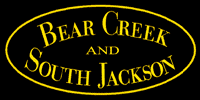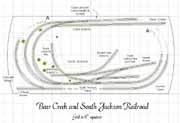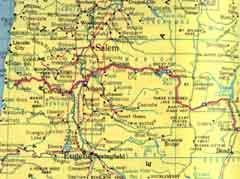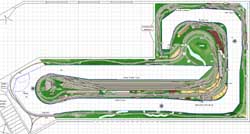Layout design brings different images to mind in different folks. For some it's an
onerous process to be gotten over as soon as possible the so fun of actual construction
and operation can begin. Others spend years researching every detail of a favorite
protype, agonizing over which portions to include or omit. Most of us like to just
doodle trackplans.
The Bear Creek and South Jackson has progressed from a 4x8 twice around to a
22 x 20 L-shaped, around the walls helix layout to a monster design for a large
basement room. As the designs have become more complex so has the need for planning.
Without carefully working things out "Oops!" could result.
While planning a layout that will actually get built (of course you never really know
but it's good to step back every so often for a sanity check) such
things as:
- Will this be too big for me (or group) to complete in a reasonable amount
of time?
- Will it require construction complexity beyond my abilities
to actually build it? (see my SPC design below)
- Will I still want the layout after it's built? Tastes change over time. If you're
designing a double-mainline racetrack will you
still want it if you decide you like industrial switching or running with
Time Table & Train Order operation?
- Can I afford the materials to build it? Track and lumber costs add up quick when
a layout gets big!
- Is the design overly grandiose? Is it just going to be too fancy?
- How long are the trains I'll run? If I want 25 car trains but can only fit in
10 foot sidings there's gonna be a conflict! Will the engines be in one town
while the caboose is in the previous one?
- Can I reach everywhere? This applies to horizontal and vertical reaching
- Does the aisle to railroad ratio make sense? It doesn't make sense to design
a railroad to support 10 train at a time operation if the aisles will only hold
6 crew members simultaneously.
- Should I build something simpler to improve my skills before tackling a big
layout?
I decided not to build my On3 South Pacific Coast design after stepping back. It was
fun to design and I've been interested in this prototype since the late 60's but there
were too many issues that would have become problems for me.
So I decided to build a much simpler layout. A 4x8 layout. In HO (I still get comments
from some of the narrow-minded types about leaving On3) standard gauge. I had doodled
a whole bunch of HO layouts for the garage but all of them left me feeling doubts
about taking on a large project. The 4x8 seemed approachable sized. Thus I planted the
seeds of the first Bear Creek & South Jackson.
Charlie Comstock - GM Bear Creek & South Jackson Railroad.









